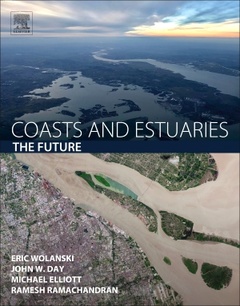Coasts and Estuaries The Future
Coordonnateurs : Wolanski Eric, Day John W., Elliott Michael, Ramesh Ramachandran

Coasts and Estuaries: The Future provides valuable information on how we can protect and maintain natural ecological structures while also allowing estuaries to deliver services that produce societal goods and benefits. These issues are addressed through chapters detailing case studies from estuaries and coastal waters worldwide, presenting a full range of natural variability and human pressures. Following this, a series of chapters written by scientific leaders worldwide synthesizes the problems and offers solutions for specific issues graded within the framework of the socio-economic-environmental mosaic. These include fisheries, climate change, coastal megacities, evolving human-nature interactions, remediation measures, and integrated coastal management.
The problems faced by half of the world living near coasts are truly a worldwide challenge as well as an opportunity for scientists to study commonalities and differences and provide solutions. This book is centered around the proposed DAPSI(W)R(M) framework, where drivers of basic human needs requires activities that each produce pressures. The pressures are mechanisms of state change on the natural system and Impacts on societal welfare (including well-being). These problems then require responses, which are the solutions relating to governance, socio-economic and cultural measures (Scharin et al 2016).
1. A Synthesis: What Is the Future for Coasts, Estuaries, Deltas and Other Transitional Habitats in 2050 and Beyond?
Section A: Estuaries 2. An Assessment of Saltwater Intrusion in the Changjiang (Yangtze) River Estuary, China 3. Río De La Plata: A Neotropical Estuarine System 4. Estuaries and Coastal Zones in the Northern Persian Gulf (Iran) 5. Protecting Water Quality in Urban Estuaries: Australian Case Studies 6. Management of Megafauna in Estuaries and Coastal Waters: Moreton Bay as a Case Study 7. Peel-Harvey Estuary, Western Australia
Section B: Deltas 8. Arctic Deltas and Estuaries: A Canadian Perspective 9. Delta Winners and Losers in the Anthropocene 10. Mississippi Delta Restoration and Protection: Shifting Baselines, Diminishing Resilience, and Growing Nonsustainability 11. Integrated Management of the Ganges Delta, India 12. The Indus Delta—Catchment, River, Coast, and People 13. A Brief Overview of Ecological Degradation of the Nile Delta: What We Can Learn 14. Status and Sustainability of Mediterranean Deltas: The Case of the Ebro, Rhône, and Po Deltas and Venice Lagoon
Section C: Wetlands, Lagoons and Catchments 15. Coastal Lagoons: Environmental Variability, Ecosystem Complexity, and Goods and Services Uniformity 16. The Everglades: At the Forefront of Transition 17. Population Growth, Nutrient Enrichment, and Science-Based Policy in the Chesapeake Bay Watershed 18. The Senegal and Pangani Rivers: Examples of Over-Used River Systems Within Water-Stressed Environments in Africa 19. Damming the Mekong: Impacts in Vietnam and Solutions
Section D: Enclosed, Semi-enclosed, and Open Coast 20. Baltic Sea: A Recovering Future From Decades of Eutrophication 21. The Black Sea—The Past, Present, and Future Status 22. Ecosystem Functioning and Sustainable Management in Coastal Systems With High Freshwater Input in the Southern Gulf of Mexico and Yucatan Peninsula
Section E: Restoration of Estuaries 23. Restoration of Estuaries and Bays in Japan—What’s Been Done So Far, and Future Perspectives 24. Challenges of Restoring Polluted Industrialized Muddy NW European Estuaries 25. Can Bivalve Habitat Restoration Improve Degraded Estuaries?
Section F: Coral Reefs 26. Successful Management of Coral Reef-Watershed Networks 27. Challenges and Opportunities in the Management of Coral Islands of Lakshadweep, India 28. The Future of the Great Barrier Reef: The Water Quality Imperative
Section G: Over-Arching Topics 29. Estuarine Ecohydrology Modeling: What Works and Within What Limits? 30. Hypersalinity: Global Distribution, Causes, and Present and Future Effects on the Biota of Estuaries and Lagoons 31. Alien Species Invasion: Case Study of the Black Sea 32. Coastal Fisheries: The Past, Present, and Possible Futures 33. Temperate Estuaries: Their Ecology Under Future Environmental Changes 34. Plastic Pollution in the Coastal Environment: Current Challenges and Future Solutions 35. Changing Hydrology: A UK Perspective
Section H: Management of Change 36. Global Change Impacts on the Future of Coastal Systems: Perverse Interactions Among Climate Change, Ecosystem Degradation, Energy Scarcity, and Population 37. Human-Nature Relations in Flux: Two Decades of Research in Coastal and Ocean Management 38. Megacities and the Coast: Global Context and Scope for Transformation 39. Arctic Coastal Systems: Evaluating the DAPSI(W)R(M) Framework
Researchers, scientists, engineers, and students of estuarine, coastal and shelf processes along with resource managers with a special interest in coastal ecosystems, hydrologists, natural resource managers, and professionals focusing on sustainable use of our coasts, estuaries, and ecosystem services
Professor John Day is an Emeritus Professor at the Department of Oceanography & Coastal Sciences, Louisiana State University. His research interests include Estuarine Ecology, Systems Ecology, Wetland Ecology, Ecological Modeling, Effects of Humans on Natural Systems, Tropical Coastal Ecology. Professor Day has edited numerous books on aquatic ecology and has contributed to numerous journal articles and special issues.
Professor Michael Elliott is the Director of the Institute of Estuarine & Coastal Studies (IECS) and Professor of Estuarine and Coastal Sciences at the University of Hull, U.K. He is a marine biologist with wide experience in teaching, research, advisory and consultancy work in estuarine and marine aspects of ecological components and communities, and the impacts of human activities, as well as policy, governance, and management of estuaries and coasts. He is a Fellow of the Royal Geographical Society and of the Society of Biology. Mike has published widely, coauthoring/coediting 15 books and contr
- Covers estuaries and coastal seas worldwide, integrating their commonality, differences and solutions for sustainability
- Includes global case studies from leading worldwide contributors, with accompanying boxes highlighting a synopsis about a particular estuary and coastal sea, making all information easy to find
- Presents full color images to aid the reader in a better understanding of details of each case study
- Provides a multi-disciplinary approach, linking biology, physics, climate and social sciences
Date de parution : 01-2019
Ouvrage de 726 p.
21.4x27.6 cm
Thèmes de Coasts and Estuaries :
Mots-clés :
Ecosystems; Restoration; Seas; Modelling; Wetlands; Coastal zones; climate change; population; lagoons; Barrier Reef; Deltas; Mekong; Baltic Sea



